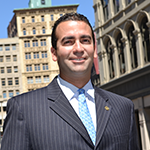Working in the hyper-competitive world of advertising can seem like scaling a mountain. For those who reach the top, it can be hard to stand still long enough to appreciate the view. It can be even more difficult to walk away.
Tony Dieste opened Dieste, Inc. (formerly known as Dieste Harmel & Partners) in 1995. His ad agency quickly became the biggest Hispanic and multicultural firm in the United States, racking up award after award. Ad Age named Dieste, Inc. as the Multicultural Agency of the Year in 2002 and again in 2004. The first firm of its kind to win a prestigious Cannes Lion, the company attracted top clients like AT&T and became respected for innovation and creativity. In 2010, due to his wife’s serious illness, Dieste announced his departure.
Industry Pulse
How has the image of latinos
changed in your industry?
Historically, we’ve been underrepresented like in many industries.
Do you see it evolving?
Yes, but the evolution has been a slow one. It was once stereo-
typical, but is getting better.
Are Latinos accurately portrayed in the media? How do
you see it changing?
Because of the sheer power, the numbers, our retail buying, and political power, we are seeing changes in many areas. Good local example: WFAA is an ABC affiliate in Dallas, and two of their top two news anchors are Latinas.
What’s your favorite news source?
Pulse Mobile App—it’s the best thing ever. I get all the news I want from every corner of the world on my smartphone and iPad. It aggregates, pulling news from thousands of sources. I’m obsessed.
Dieste was at the top of his industry, but after only a nine-month hiatus, chose to join a prestigious Dallas-based private equity firm and leave advertising behind to pursue his interests in technology and mobility.
Born and raised in Mexico, Dieste moved to the United States for college. He got an early start in sales and marketing when he started importing shaved ice and gelato at age 19. One store became two, and two became 13. Suddenly, he was faced with a decision—college or ice cream? He sold the business and earned his degree.
The early experience, however, left an impression on the young Dieste that would influence his career. “I had already taken some serious licks from the retail world,” he recalls. “I learned how to hire a management team, how to scale a business, how to market, how to franchise, how to brand. It was invaluable.”
When Dieste met Warren Harmel, the duo recognized the potential in combining Dieste’s creativity, business building skills, and passion with Harmel’s business acumen. They formed Dieste Harmel & Partners and focused on multicultural brand communications. By the time Dieste left the shop, its top clients included Fortune 100 companies like AT&T, Procter & Gamble, PepsiCo, and Nationwide.
He had spent 15 years at the top of the advertising world leading a respected and growing team of multicultural marketers. He had pushed to innovate, to pioneer, to revolutionize. And despite the successes, too much was left unchanged. He left the industry and piled up priceless experience in the world of private equity and technology. His phone rang every month with job offers from relentless headhunters, prominent companies, and global institutions. He resisted every professional temptation, every business offer. And then, thankfully, his wife’s health returned. Dieste was lured back to his field soon after exiting. “I have to give Greg Knipp a lot of credit for getting me back to the agency. We had several conversations and realized that we would make an incredible team,” Dieste says.
The time away from advertising gave him a new perspective. “Now I see advertising with totally different eyes,” he says. “Parts of the business still looks very archaic to me. It’s like a beetle stuck in amber—parts haven’t changed in years.” In private equity, Dieste ran mobile, technology, and cloud-based businesses—which are exactly the structures into which his advertising clients want to tap. Marketing, however, still tries to reach its audience in old ways. “Advertising, in many ways, is outdated. It’s linear. It no longer reflects the market or consumers,” Dieste says.
This time, he is partnered with Knipp, who Dieste claims is the best operator in the business. Now, Dieste and Knipp have set their minds to changing the agency to reflect a changing audience. “The whole intent is to move faster, to fail faster, and to get better work in and out,” he says. Today’s audience is fragmented. Users wake up, check Twitter and Facebook in bed, read online articles, and listen to web radio on their daily commute. A modern ad firm must respond. Dieste, Inc. has built a new creative process known as “Adgile” that was designed to meet the needs of the 2.0 world. Birthed from Dieste’s foray into the digital world, Adgile combines the best elements of the software Adgile system with the best of the advertising creative process. These new collaboration tools and mobile-software platforms are replacing legacy systems. Dieste has hired new media experts and creative technologists, data miners, and analytics experts. “Over the past two years, Dieste replaced several employees with traditional advertising backgrounds with those that are more digitally native and T-shaped,” Knipp says.
The advertising world finds itself at an unusual and unfamiliar place—one Dieste describes as “a step away from chaos.” Creatives must throw out the rule book and get daring. “TV and print are no longer the answers. We’re often developing mobile only platforms, so we’ve got to work fast, see what’s working, and adapt very quickly,” he says. Audiences are getting smaller, but better connected. Unlike in previous
generations, brands can be made—or destroyed—overnight.
Success in this new world will come from data, technology, and creativity—Dieste’s “triple threat” of successful marketing in the modern era. “The content wars are coming, and we want to be a part of the change and help shape the conversation,” he says, adding that the newly positioned ad shop is set up for victory.
While rapid changes are dictating that companies get faster and more mobile, content is still king. “There’s a lot of confusion out there right now both by agencies and clients, but we must keep the integrity of the message,” Dieste says. Agencies are still storytellers, after all, no matter how the message is deployed. Dieste, Inc.’s new employees focus on the solution regardless of the medium, and are what the chairman calls “media agnostic,” willing to adapt to what best serves the consumer. While traditional shops build episodic campaigns that operate like one-off military battles, Dieste builds robust platforms, providing utility and then building on it.
“Our clients want solutions that are very creative, and they want to build brand affinity for their products or services,” Knipp says. What keeps them coming back is the company’s consistency and working relationships. “We’re fun to work with,” Dieste says. “Sometimes people take that for granted.”
Not only do the creatives at Dieste understand the art and science behind successful marketing, they know how to craft effective messages to reach a specific consumer. Dieste says each person in his team must be “maniacally creative and obsessed with the work.” Five things drive the company culture: robust data, thorough briefs, clear customer expectations, effective training, and pervasive technology.
Dieste—the man and the company—have been through a lot. After all that’s happened, he’s once again embraced the advertising world for its ability to inspire.

